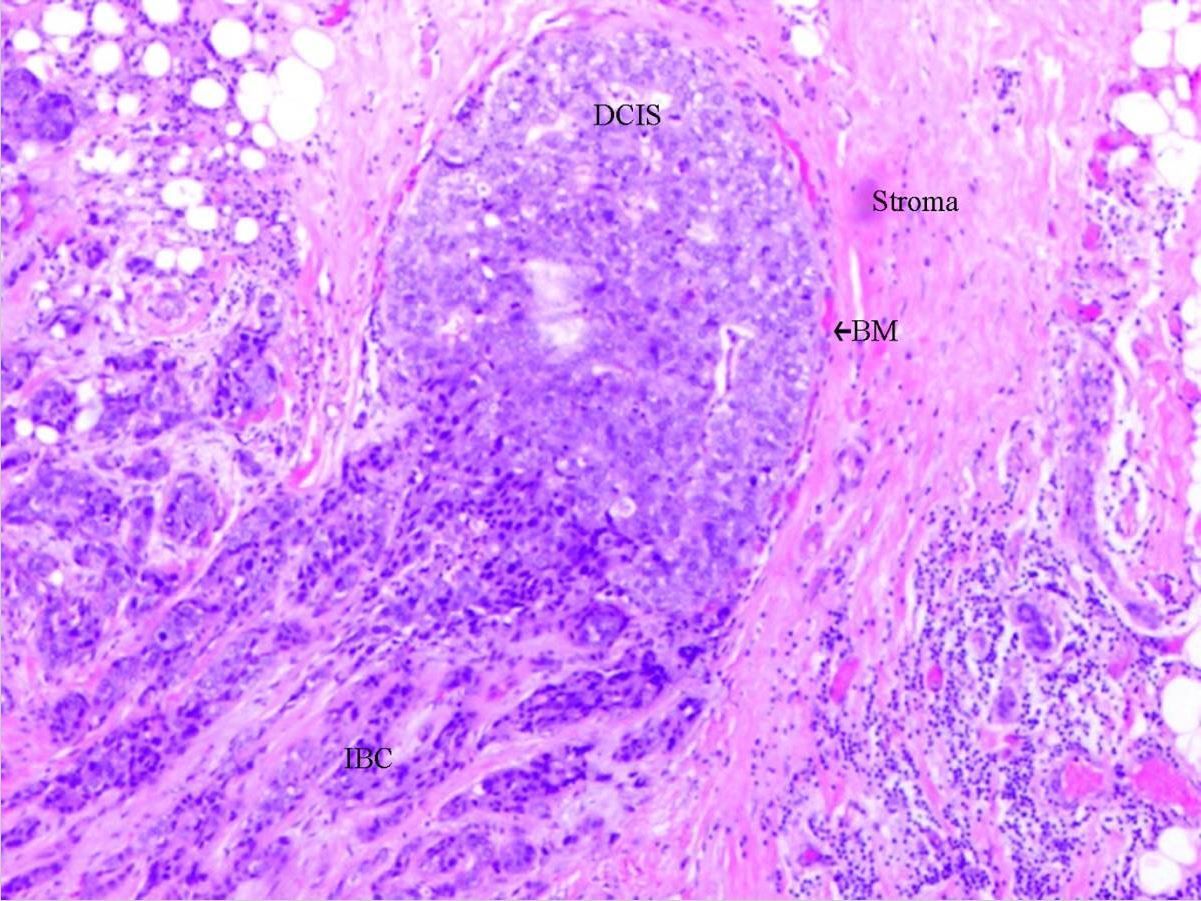Playlist
Show Playlist
Hide Playlist
Types of Invasive Breast Cancer
-
Slides Breast Female Repro.pdf
-
Download Lecture Overview
00:01 To continue the discussion of breast cancer. 00:04 We’ll now move into invasive. 00:06 The most common invasive breast cancer is invasive ductal cancer. 00:13 So if you’re thinking about ductal, what just happened here that now resulted in invasion? Invaded through the basement membrane. 00:20 Firm, fibrous, rock hard mass with sharp margins. 00:26 And here, you would call this a stellate type of classic morphology. 00:31 Worst and most invansive and most common, 76% of all breast cancers invasive type are the ductal. 00:42 If that’s a ductal, then we have invasive lobular. 00:45 And, my goodness, is this dangerous. 00:47 Invasive lobular cancer is the one that loves to spread. 00:51 Oftentimes, you’d find this to be bilateral. 00:55 You would find a row of cells. 00:56 You might have heard of the term “Indian filing” or a bunch of cells that are marching in front of the other. 01:03 This is invasive lobular cancer. 01:07 Medullary: Fleshy, cellular, lymphocytic infiltration. 01:11 Good prognosis for breast cancer. 01:14 Good. 01:16 Inflammatory: The opposite of good. 01:19 The 50% survival in 5 years. 01:22 So what is inflammatory? This is the one that you have come to know and you have heard of, the skin of an orange. 01:29 Peau d'orange in French, the dermal lymphatics. 01:33 What’s going on here? Now, I’m going to bring something to your attention. 01:37 You’re going to be paying attention to, when you study, Paget’s disease of the nipple. 01:43 Inflammatory disease of breast cancer and you’re going to be paying attention to erythema in general of the breast, such as your acute mastitis. 01:53 The reason I bring these to your attention is because oftentimes, your breast will then appear as being red or erythematous. 01:59 But each one’s a little bit different. 02:01 And inflammatory looks that of a skin of an orange, literally. 02:04 Breast, what’s happening here? At least know that the dermal, lymphatic invasion by breast cancer, invasive. 02:11 So lymphatics are being involved. 02:13 Neoplastic cells block the lymphatic drainage, resulting in what’s known as your lymphedema. 02:19 This then looks like exactly as to what you would expect, the skin of the orange. 02:25 Here's Paget’s disease. 02:27 Here as well. 02:28 Be careful, the reason I say that is because this would be – Well, involvement of the nipple, you you would have reddening as well, erythema of the breast, but this reddening or the skin that you see in Paget’s disease of the nipple does not look at all like a skin of orange. 02:46 So what does the redness and erythema look like in Paget’s disease? It will look exactly like eczema. 02:53 And look for that description. 02:54 As we dive further into the details of it, it suggests an underlying carcinoma. 03:01 "Dr. Raj, I though Paget’s disease of the nipple was bad enough." Yes, it is. 03:05 But 50% of the time, if not more, there’s an underlying cancer of the breast that also is involved. 03:12 Oftentimes, it will be ductal as we shall discuss. 03:15 A brief nice little overview of what you can expect with invasive breast cancer. 03:20 With non-invasive, I only talked to you about ductal carcinoma in situ and I brought comedocarcinoma to your attention.
About the Lecture
The lecture Types of Invasive Breast Cancer by Carlo Raj, MD is from the course Reproductive Pathology: Breast Disease with Carlo Raj.
Included Quiz Questions
Which of the following is LEAST likely to metastasize?
- Ductal carcinoma in situ
- Invasive ductal carcinoma
- Medullary carcinoma of the breast
- Inflammatory carcinoma of the breast
- Invasive lobular carcinoma
Which statement about inflammatory breast cancer is TRUE?
- It often presents with “peau d’orange” of the skin of the breast.
- It often presents as a firm, “rock-hard” mass with sharp margins.
- It represents more than 50% of all breast cancers.
- It has the best prognosis for the different types of breast cancer.
- It is associated with a classic “stellate” morphology.
Customer reviews
5,0 of 5 stars
| 5 Stars |
|
1 |
| 4 Stars |
|
0 |
| 3 Stars |
|
0 |
| 2 Stars |
|
0 |
| 1 Star |
|
0 |
Another perfect lecture! I finally understood this theme after a long period trying with another material. Thanks a lot Dr Raj





